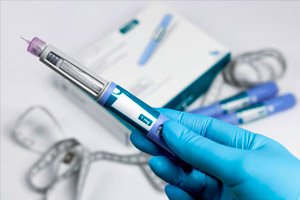
All iLive content is medically reviewed or fact checked to ensure as much factual accuracy as possible.
We have strict sourcing guidelines and only link to reputable media sites, academic research institutions and, whenever possible, medically peer reviewed studies. Note that the numbers in parentheses ([1], [2], etc.) are clickable links to these studies.
If you feel that any of our content is inaccurate, out-of-date, or otherwise questionable, please select it and press Ctrl + Enter.
Obesity drugs are associated with reduced alcohol consumption
Last reviewed: 03.07.2025
 ">
">Anti-obesity drugs are associated with reduced alcohol consumption, possibly due to their effects on craving and reward systems, with an additional role for behavioral strategies.
In a recent study published in JAMA Network Open, researchers assessed changes in alcohol use among participants in a telemedicine weight management program after starting treatment with anti-obesity medications (AOM).
How do anti-obesity drugs affect alcohol consumption?
Anti-obesity drugs such as glucagon-like peptide-1 receptor agonists (GLP-1 RAs) are effective in producing significant weight loss. GLP-1 RAs have also been shown to be associated with reduced incidence and relapse of alcoholism, suggesting that these drugs may have dual benefits.
Studying the effects of different ABMs on alcohol use may provide valuable insights into their broader behavioral effects. Comparative studies of different ABMs and their effects on alcohol use may help to better understand their therapeutic mechanisms and applications.
About the progress of the research
The study included patients recruited from the WeightWatchers (WW) Clinic telemedicine weight management program. Inclusion criteria included patients who started taking AOM between January 2022 and August 2023 and had a repeat prescription of the same drug in October-November 2023.
The study was approved by the Henry Ford Health System Institutional Review Board. Participants did not provide informed consent, as the data were collected as part of clinical care and were de-identified. The study followed STROBE standards.
The drugs were classified as follows:
- Bupropion, metformin and naltrexone,
- First-generation GLP-1 agonists such as liraglutide and dulaglutide,
- Second-generation GLP-1 agonists such as tirzepatide and semaglutide.
Patients who were taking AOM before the study or had a history of bariatric surgery were excluded because their risk of alcoholism differs.
Baseline questionnaires collected demographic data including age, sex at birth, race, ethnicity, height, weight, and weekly alcohol consumption. Body mass index (BMI) was calculated from these data.
All participants completed follow-up questionnaires reporting alcohol use at the time of AOM refill. Multivariable logistic regression was used for analysis, controlling for weight and alcohol use factors. Analyses were performed using R software.
Research results
A total of 14,053 people were recruited, 86% of whom were women. The average age of participants was 43.2 years, and the average BMI was 36.
More than 86% of participants used second-generation GLP-1 agonists. The remainder used first-generation agonists, bupropion/naltrexone, or metformin. Participants represented a variety of obesity classes: 41.3% were in class I, 26% in class II, and 21% in class III.
At baseline, 53.3% of participants reported alcohol use, including:
- 45.3% reduced its consumption after starting AOM treatment,
- 52.4% did not change their habits,
- 2.3% increased consumption.
Overall, 24.2% of participants reduced their alcohol consumption. People with higher obesity class and higher initial alcohol consumption were more likely to report reduced consumption.
Participants taking bupropion/naltrexone were more likely to reduce their alcohol consumption compared to those using metformin. However, this association was no longer statistically significant after weight loss was taken into account, indicating that the reduction in alcohol consumption was partly due to the weight loss itself.
The average duration between the start of AOM intake and the follow-up survey was 224.6 days, during which time participants lost an average of 12.7% of their baseline weight.
Conclusions
Nearly half of the participants who drank alcohol reduced their consumption after starting AOM. Possible mechanisms for this association include pharmacological effects, such as naltrexone's ability to reduce alcohol craving, and the effects of GLP-1 RAs in reducing the rewarding effects of alcohol.
The reduction in alcohol consumption in metformin users may reflect behavioural changes associated with weight management programmes, where alcohol restriction promotes caloric intake and increases cognitive self-control. Motivated participation in such programmes may also have played a role.
